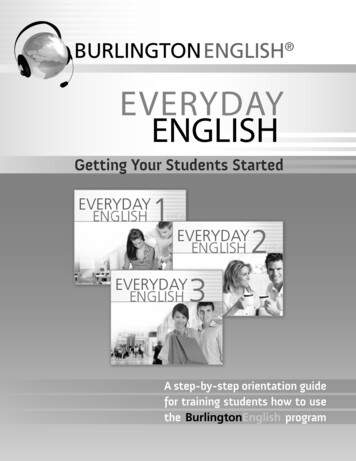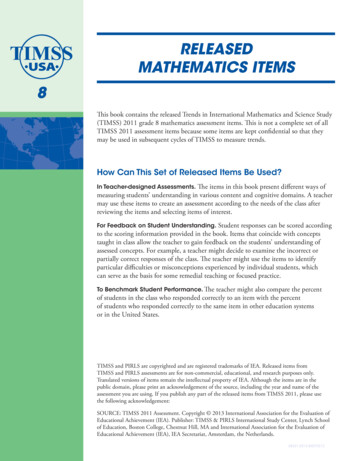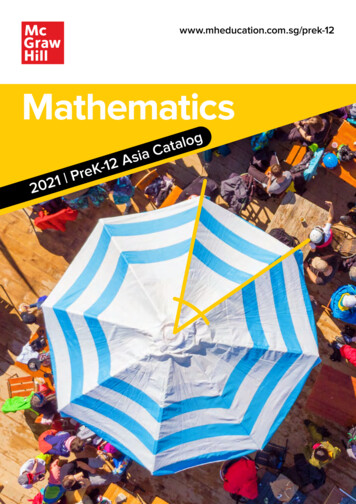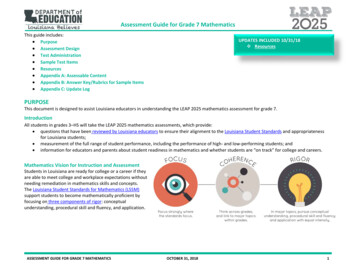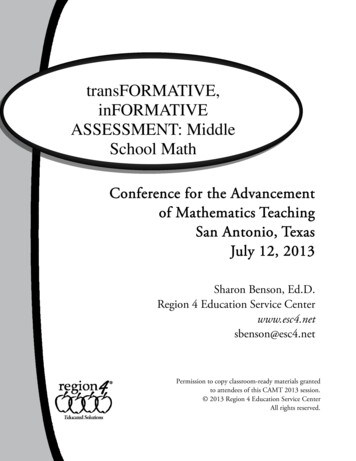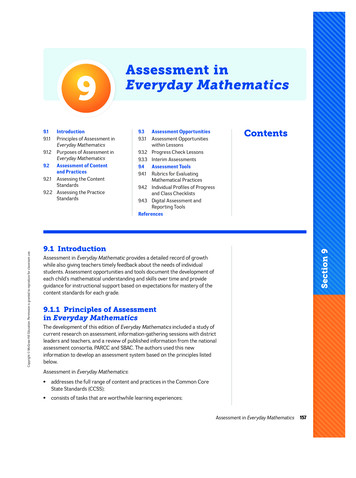
Transcription
9Assessment inEveryday MathematicsIntroductionPrinciples of Assessment inEveryday Mathematics9.1.2 Purposes of Assessment inEveryday Mathematics9.2 Assessment of Contentand Practices9.2.1 Assessing the ContentStandards9.2.2 Assessing the PracticeStandards9.39.3.1Assessment OpportunitiesAssessment Opportunitieswithin Lessons9.3.2 Progress Check Lessons9.3.3 Interim Assessments9.4 Assessment Tools9.4.1 Rubrics for EvaluatingMathematical Practices9.4.2 Individual Profiles of Progressand Class Checklists9.4.3 Digital Assessment andReporting ToolsReferencesContents9.1 IntroductionSection 9Copyright McGraw-Hill Education. Permission is granted to reproduce for classroom use.9.19.1.1Assessment in Everyday Mathematic provides a detailed record of growthwhile also giving teachers timely feedback about the needs of individualstudents. Assessment opportunities and tools document the development ofeach child’s mathematical understanding and skills over time and provideguidance for instructional support based on expectations for mastery of thecontent standards for each grade.9.1.1 Principles of Assessmentin Everyday MathematicsThe development of this edition of Everyday Mathematics included a study ofcurrent research on assessment, information-gathering sessions with districtleaders and teachers, and a review of published information from the nationalassessment consortia, PARCC and SBAC. The authors used this newinformation to develop an assessment system based on the principles listedbelow.Assessment in Everyday Mathematics: addresses the full range of content and practices in the Common CoreState Standards (CCSS); consists of tasks that are worthwhile learning experiences;Assessment in Everyday Mathematics0157 0178 EM4 T IG GK6 S9 140777.indd 157Program: Everyday Math 4Component: Implementation GuideVendor: MPSGrades: K–615723/04/15 7:21 PMPDF-Pass
is manageable for teachers; informs instruction by providing actionable information about students’progress; provides information for grading; clarifies the Everyday Mathematics spiral and helps teachers decide whento intervene and when “watchful waiting” is appropriate; serves basic Tier 1 and Tier 2 Response to Intervention (RtI) screening andprogress monitoring functions; and provides information that will complement data from external standardsbased assessments, including those from PARCC and SBAC. Although theassessments in Everyday Mathematics are designed to complementexternal assessments, the curriculum-embedded assessments are notdesigned to serve many functions of high-stakes assessments, such asprogram evaluation and teacher accountability.9.1.2 Purposes of Assessmentin Everyday MathematicsAssessment in this edition of Everyday Mathematics serves two mainfunctions: to support learning and to measure achievement. Each purpose isintegral to a successful assessment plan.Section 9For more information, seeSection 9.3 AssessmentOpportunities.For more information, seeSection 9.4 Assessment Tools.158Summative assessment measures student growth and achievement. Asummative assessment might be designed, for example, to determine whetherstudents have learned certain material by the end of a given period of study.Assessment opportunities, tools, and techniques often serve more than onepurpose in Everyday Mathematics. For example, each regular lesson and OpenResponse and Reengagement lesson includes a daily assessment opportunity(an Assessment Check-In) that provides information on student expectationsfor the lesson’s focus content and suggestions for follow-up instruction basedon student performance. When teachers use the information to addressstudents’ needs and plan instruction, the purpose is formative. When teachersuse the results for grades and progress reports, the purpose is summative.Ideally, teachers will regularly gather and use information for both purposes tohelp them achieve a balanced approach to assessment that meets their needs.Copyright McGraw-Hill Education. Permission is granted to reproduce for classroom use.Formative assessment supports learning by providing information aboutstudents’ current knowledge and abilities so teachers can plan instructionmore effectively. It encourages teachers and students to identify areas ofweakness or strength so they can focus their efforts more precisely. Formativeassessment occurs when student thinking is examined and the studentreceives feedback and instruction that moves learning forward. Formativeassessment is not an instrument or a fixed set of assessments. Instead it is aprocess that takes place as teachers and students interact in real time in theclassroom and as teachers examine student work outside the classroom.Assessment in Everyday Mathematics0157 0178 EM4 T IG GK6 S9 140777.indd 15823/04/15 7:21 PMProgram: Everyday Math 4Component: Implementation GuideVendor: MPSGrades: K–6PDF-Pass
9.2 Assessment of Content and PracticesEveryday Mathematics integrates instruction and assessment of mathematicalpractices with instruction and assessment of grade-level content. Themathematical practices are not to be separated from the content; they aremathematical habits of mind students should develop as they learnmathematical content.For information on the digitalEvaluation Tool, see Section 9.4.3.Digital Assessment andReporting Tools.However, the content and practice standards in the CCSS differ from eachother in important respects. The content standards describe specific goalsthat are organized by mathematical domain and differ from grade to grade.The practice standards describe general, cross-grade goals that are related toprocesses such as problem solving, reasoning, and modeling. Assessingwhether a student has mastered specific skills or understandings is differentfrom assessing whether that student is progressing in proficiency withmathematical practices such as problem solving or reasoning. Many tasks inEveryday Mathematics provide opportunities to assess both content andpractice standards. However, due to the differing nature of these standards,Everyday Mathematics assesses and tracks progress on them in different ways.9.2.1 Assessing the Content StandardsEach grade’s Common Core content standards are unpacked into 45 to 80Everyday Mathematics Goals for Mathematical Content (GMC). The standardsand the corresponding GMCs are listed in the back of each grade’s Teacher’sLesson Guide and in the Teacher Center.For information on the CCSScontent standards and EverydayMathematics GMCs, see Section1.1.5 Unpacking the ContentStandards.Standards for Mathematical ContentDomain Operations and AlgebraicThinking 2.OASection 9Copyright McGraw-Hill Education. Permission is granted to reproduce for classroom use.Common Core State StandardsEveryday MathematicsGoals for Mathematical ContentCluster Represent and solve problems involving addition and subtraction.2.OA.1 Use addition and subtraction within 100 to solve oneand two-step word problems involving situations of adding to,taking from, putting together, taking apart, and comparing,with unknowns in all positions, e.g., by using drawings andequations with a symbol for the unknown number to representthe problem.GMCGMCGMCGMCthe first standardunder this DomainModel 1-step problems involvingaddition and subtraction.Use addition and subtraction tosolve 1-step number stories.Model 2-step problems involvingaddition and subtraction.Use addition and subtraction tosolve 2-step number stories.program goals forfiner-grained tracking ofstudent progress.Excerpt from the table listing the Common Core State Standards andcorresponding GMCs, Grade 2 Teacher’s Lesson GuideAssessment in Everyday Mathematics0157 0178 EM4 T IG GK6 S9 140777.indd 159Program: Everyday Math 4Component: Implementation GuideVendor: MPSGrades: K–615923/04/15 7:21 PMPDF-Pass
For more information on theSpiral Tracker, see Section 2.2.1The Spiral: How EverydayMathematics DistributesLearning.The online Spiral Tracker provides detailed information about learningtrajectories leading to mastery of the content standards. For each standard,the Tracker displays most related activities and assessments and the GMCsthat each task focuses on. Information from the Spiral Tracker can be usefulfor detailed assessment of student learning and for planning differentiation. Goto connectED.mcgraw-hill.com to access the Spiral Tracker.For more information. seeSection 9.3 AssessmentOpportunities.For more information, seeSection 9.4 Assessment Tools.Most assessment opportunities in the program are clearly tagged with one ormore content standards. Within the online assessment and reporting system,these opportunities are also linked to the finer-grained GMCs, allowing fordetailed tracking of student performance on standards and curriculum goals.Each task that assesses a content standard embeds information aboutreasonable expectations for that standard at that point in the year. IndividualProfiles of Progress, Class Checklists, and the digital assessment and reportingtools help teachers monitor students’ progress and target differentiation.9.2.2 Assessing the Practice StandardsFor more information on theStandards for MathematicalPractice and EverydayMathematics GMPs, see Section1.2 Standards for MathematicalPractice.Since the Standards for Mathematical Practice in the CCSS are broadlywritten for Grades K to 12, Everyday Mathematics includes specific Goals forMathematical Practice that unpack the Standards for Mathematical Practice(SMP) for elementary school teachers and students. These EverydayMathematics Goals for Mathematical Practice (GMP) can be useful forassessing the mathematical practices because they highlight key aspects ofeach practice.Tracking and evaluating progress on the mathematical practices requires amore qualitative approach. Assessment opportunities for the practices includewriting/reasoning prompts, open response problems, Assessment Check-Ins,Progress Check lessons, and observations of students in the course of dailywork. Tools for assessing and tracking progress on the practices includechecklists and task-specific rubrics for open response problems.Copyright McGraw-Hill Education. Permission is granted to reproduce for classroom use.Section 9Spiral Tracker for Grade 2, Lesson 6-10 available through the Standards button on theOverview page160 Assessment in Everyday Mathematics0157 0178 EM4 T IG GK6 S9 140777.indd 16023/04/15 7:21 PMProgram: Everyday Math 4Component: Implementation GuideVendor: MPSGrades: K–6PDF-Pass
9.3 Assessment OpportunitiesIn addition to the identified formal assessments, almost any task in EverydayMathematics can serve as an informal assessment opportunity. For example,Math Boxes, including those with Writing/Reasoning prompts, can be useful inassessing student proficiency. Other tasks, such as Mental Math and Fluencyexercises and journal problems, may also be useful for tracking studentlearning at a detailed level. The Spiral Tracker can help teachers identify tasksand activities related to a standard of interest for informal assessment.Copyright McGraw-Hill Education. Permission is granted to reproduce for classroom use.Data from both formal and informal assessment opportunities can be collectedand analyzed using the online assessment tools. In order to preserve theintegrity of the program’s system of formal assessments, the digital reportingsystem provides separate reports for formal and informal assessments.Since mastery in a spiral curriculum develops over time, the program providesinformation about expectations for mastery throughout each grade. Suchinformation, combined with information about how much instruction andpractice remains for each standard, helps teachers decide whetherintervention or “watchful waiting” is more appropriate for students who arestruggling. If, for example, a student is struggling with a standard that has onlyrecently been introduced, it may be appropriate to watch and wait rather thanintervene immediately. If, on the other hand, a student is struggling with astandard that is almost complete, intervention may be more appropriate.Assessment is indicated with a redcheckFor information on tracking andrecording tools, see Section 9.4Assessment Tools.For more information, seeSection 2.2 Design of EverydayMathematics.For more information, seeSection 9.4.3 Digital Assessmentand Reporting Tools.Section 9Everyday Mathematics offers many opportunities for assessment of contentand practices. Certain of these opportunities have been designated as formalassessments. Formal assessments include Assessment Check-Ins, which areembedded in most lessons; two-day Progress Check lessons at the end ofeach unit; and Interim Assessments at the middle and end of each grade.Formal assessments are indicated by a red checkmark in both digital and printteacher materials. The formal assessments embedded in EverydayMathematics provide balanced and comprehensive information for informinginstruction and assigning grades—they are all “fair to grade”.The information below is organized into three subsections. Section 9.3.1 discusses ongoing, lesson-embedded opportunities. Section 9.3.2 discusses Progress Check lessons in Grades 1 through 6. Section 9.3.3 discusses Interim Assessments, including Beginning-of-Yearassessments9.3.1 Assessment Opportunities within LessonsAssessment Check-InsGRADE LEVELWhere: Within the Focus section of the lessonFrequency: Every regular and Open Response and Reengagement lessonFormal: YesAssessment in Everyday Mathematics0157 0178 EM4 T IG GK6 S9 140777.indd 161Program: Everyday Math 4Component: Implementation GuideVendor: MPSGrades: K–616123/04/15 7:21 PMPDF-Pass
Primary Purpose: Assessment Check-Ins are lesson-embedded opportunitiesto assess the focus content and practices of the lesson. They address the maincontent in each lesson, provide specific information on mastery expectations,and offer follow-up suggestions based on students’ performance.All Assessment Check-Ins describe expectations for that point in thecurriculum for up to three content or practice standards. They clarify whetherstudents are not yet expected to have mastered the content or are expected tohave partially mastered it at that time. Assessment Check-Ins offer ideas forassisting students who struggle (and sometimes for those who excel). TheAssessment Check-In may describe a particular activity to support individualstudents, point to an Adjusting the Activity note, or suggest the use of adifferentiation option or game.The Assessment Check-In, Grade 5 Lesson 1-4, is accessible through theActivities view in the Teacher Center162Copyright McGraw-Hill Education. Permission is granted to reproduce for classroom use.Section 9Assessment Check-In, Kindergarten Lesson 1-10 from the Teacher’s Lesson GuideAssessment in Everyday Mathematics0157 0178 EM4 T IG GK6 S9 140777.indd 16223/04/15 7:21 PMProgram: Everyday Math 4Component: Implementation GuideVendor: MPSGrades: K–6PDF-Pass
Open Response and Reengagement lessons contain Assessment Check-Insthat focus on expectations for the content standard(s) addressed in theproblem and point teachers to a task-specific rubric to assess student work ona target Goal for Mathematical Practice. Each Open Response andReengagement lesson includes evaluated student work samples to helpteachers understand how to evaluate their own students’ work.For more information onassessing the practicestandards in Open Responseand Reengagement lessons, seeSection 6.2.5 Evaluating StudentPerformance.Assessment Check-In, Grade 2 Open Response and Reengagement Lesson 7-2For more information on usingrubrics to assess themathematical practices, seeSection 9.4 Assessment Tools.Each Section or Unit Organizer provides a list of Assessment Check-Ins withthe standards each task assesses.Section 9Copyright McGraw-Hill Education. Permission is granted to reproduce for classroom use.Task-specific rubric, Grade 2 Open Response and Reengagement Lesson 7-2Grade 1 Unit 5 Assessment Check-Ins from the Unit OrganizerAssessment in Everyday Mathematics0157 0178 EM4 T IG GK6 S9 140777.indd 163Program: Everyday Math 4Component: Implementation GuideVendor: MPSGrades: K–616323/04/15 7:21 PMPDF-Pass
Preview Math BoxesGRADE LEVELKWhere: In the Practice portion of some lessonsFrequency: One pair per unit near the end of each unitFormal: NoPrimary Purpose: In Grades 1–6, a set of paired Preview Math Boxes appear ineach unit. Problems in paired Math Boxes pages appear in the same order andaddress the same content as one another, with subtle changes to the contextor numbers. The Preview Math Boxes can be used to gauge students’ readinessfor the upcoming unit so that teachers can plan instruction and chooseappropriate differentiation activities for individual students, for small groups,and for the whole class.Copyright McGraw-Hill Education. Permission is granted to reproduce for classroom use.Section 9For general information aboutMath Boxes, see Section 4.2.5Practice. For informationabout using Math Boxes fordifferentiation, see Section 10.2.1Differentiation Features inLessons.In Grade 5, paired Preview Math Boxes for Unit 3 are in Lessons 2-10 and 2-14. Both areaccessible in the print journal and in the Student Learning Center.164 Assessment in Everyday Mathematics0157 0178 EM4 T IG GK6 S9 140777.indd 16423/04/15 7:22 PMProgram: Everyday Math 4Component: Implementation GuideVendor: MPSGrades: K–6PDF-Pass
Writing/Reasoning PromptsGRADE LEVELKWhere: Within regular Math BoxesFrequency: In about half of the lessonsFormal: NoPrimary Purpose: Many Math Boxes have writing/reasoning prompts thatprompt students to communicate their understanding of concepts and skillsand their strategies for solving problems. They help students extend anddeepen their mathematical thinking. Writing/reasoning prompts providevaluable opportunities for assessing the Standards for Mathematical Practice.For information on usinggeneric rubrics to assess themathematical practices, seeSection 9.4.1 Rubrics forEvaluating MathematicalPractices.Writing/Reasoning Prompt, Grade 2 Lesson 2-10Almost any task in Everyday Mathematics can provide information thatteachers may find useful for informal assessment. Assessment tools, includingthe print checklists and the online assessment and reporting system, canaccommodate data from sources other than the formal assessments. Teachersshould use their judgment about expanding the range of data they gather andhow best to use the additional information to inform instruction and assigngrades. For example, in assessing student learning, some teachers may find ithelpful to gather data from Home Links or make observations while studentsplay games, work on hands-on activities, or engage in partner discussions.Since every Math Boxes problem is tagged with specific standards, someteachers may find them particularly useful for assessment.Section 9Copyright McGraw-Hill Education. Permission is granted to reproduce for classroom use.Other Lesson-Embedded AssessmentMany teachers create math portfolios by working with students to collectsamples of their work throughout the year. Portfolios allow students andteachers to clearly see growth over time, to demonstrate progress to parentsand other teachers, to capture individual interests and approaches, and toassess each student’s learning. This permits teachers to take a broader view oftheir students’ progress and may be particularly illuminating with respect tothe mathematical practices, since students’ collected work throughout theyear will likely demonstrate growth in communication skills and new strategiesstudents have learned to solve familiar and unfamiliar problems. Students whouse the digital Student Learning Center have access to a “Favorites” button.Students can use this function to develop a digital portfolio by archiving theirfavorite work or work that a teacher directs them to save.Assessment in Everyday Mathematics0157 0178 EM4 T IG GK6 S9
that each task focuses on. Information from the Spiral Tracker can be useful for detailed assessment of student learning and for planning differentiation. Go to connectED.mcgraw-hill.com to access the Spiral Tracker. Spiral Trac
